Can the RBA learn from the Fed’s experience?
Through a combination of historical competence (relatively low inflation), and a little good fortune the RBA can avoid the travails of the Fed.
Even after the March meeting, the Fed looks to be behind the curve when it comes to the withdrawal of monetary stimulus.
Inflation, as measured by the US February CPI, was at its highest level since 1982.
The magnitude, persistence and momentum in US inflation remain challenging.
US inflation was already showing stubborn persistence before the Ukraine conflict erupted. Sophisticated measures of the ‘inflation pulse’ (ex ‘base effects’) show an undiminished acceleration in inflation from as far back as late 2020. Currently, these measures are above 6 per cent on an annualised basis (closer to 7 per cent in the case of the trimmed-mean measure).
It is not just energy prices and supply chain blockages attendant on the pandemic that are behind the re-emergence of inflation.
Other factors are at work including the reversal of the two great structural trends that account for the deflationary tendency of the past three decades: viz; globalisation of labour supply and peak baby boomer workforce participation.
Also front and centre is the extended period of excessively accommodative monetary policy itself.
Long dormant measures of inflation expectations – both survey-based and market-based – are on the rise. Inflation expectations have a habit of being self-fulfilling through their effect on wage and price setting behaviour
Adding to the mix is an increasing proclivity for Governments to resort to protectionist policies and a renewed market-regulatory agenda in developed countries that, even if focussed on laudable objectives, inevitably add to price pressures.
Still, for the Fed, it may be a case of better late than never.
For the RBA, Australia’s relatively benign starting point for inflation means that a judicious and timely increase in the policy rate means a lower terminal rate.
In this context recent comments from Governor Lowe that appear to create more flexibility for the RBA to respond to satisfaction of ‘outcomes’ are sensible.
Under the RBA ‘outcomes-based forward guidance’ framework, the objectives on inflation and unemployment appear to have been met. The March labour force revealed an unemployment rate of 4.0% – as low as it has been in almost 50 years!
On wages, the most recent December Wage Price Index showed private sector wages including bonuses growing at 3.0% – the highest rate of annual increase in eight years. Meanwhile, there is quite widespread statistical and anecdotal evidence of accelerating – some would say overdue – wage growth.
Moreover, Lowe’s recent comments imply that RBA forecasts are located on the downside end of the inflation risk continuum.
In this context, a policy rate rise around mid-year is desirable and will likely be supported by the CPI and WPI releases before that time.
In a central banking twist on the old expression, it may be the case that a hike in time saves nine.
Stephen Miller is an Investment Strategist with GSFM. The views expressed are his own and do not consider the circumstances of any investor. This article was published by The Australian Financial Review on 17 March 2022.






